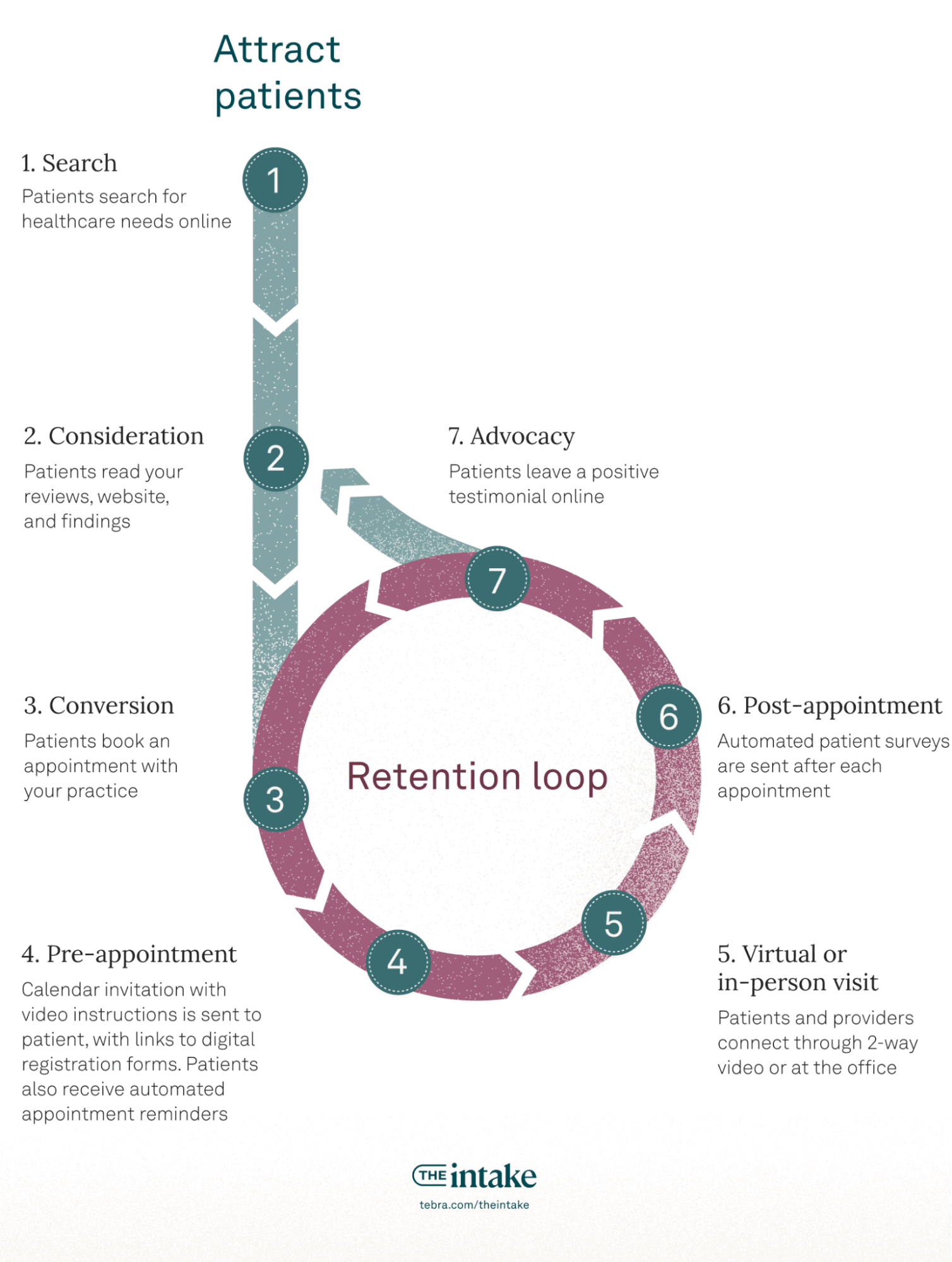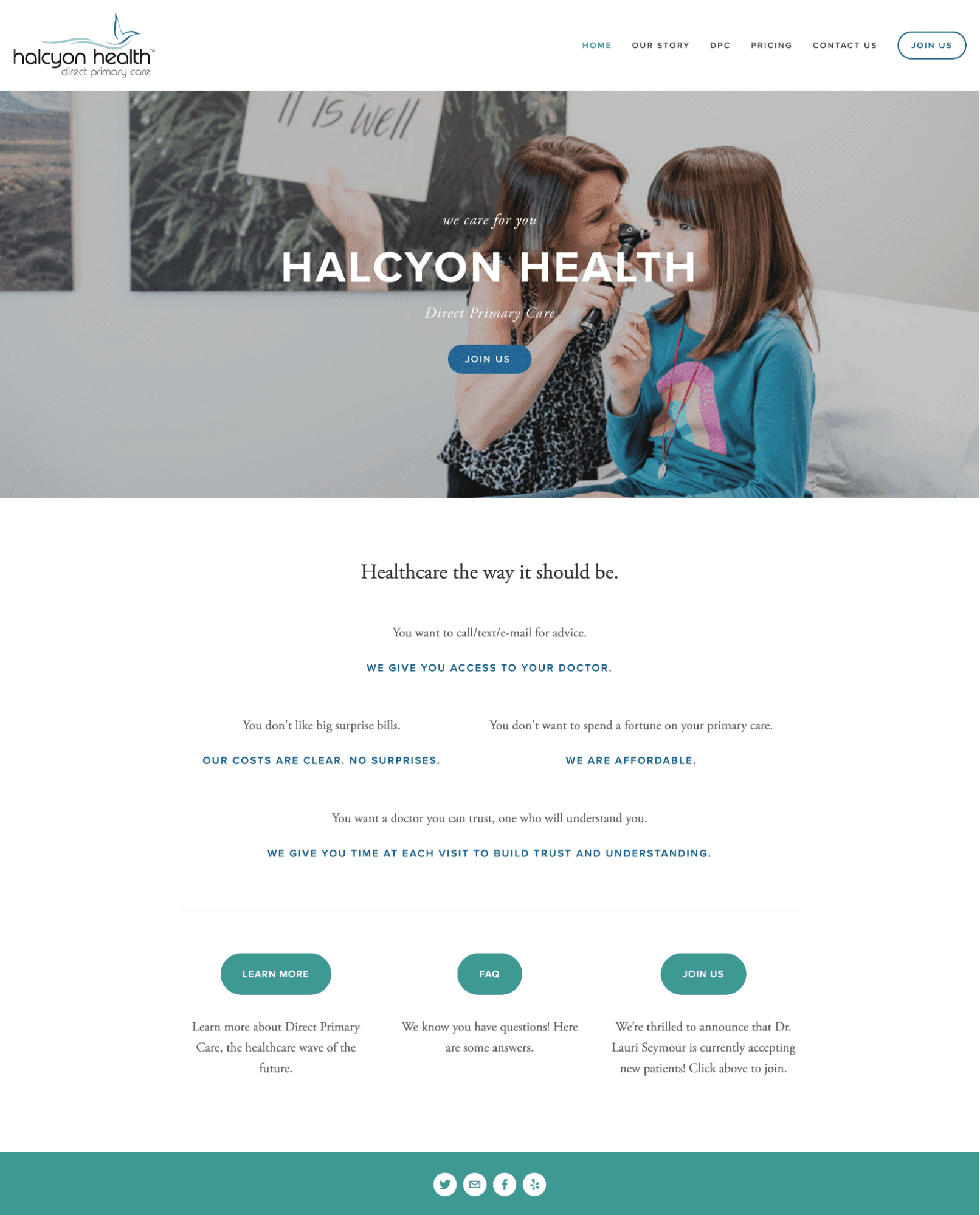Future-proof your practice with digital patient experiences
Technology is the cornerstone of modernizing your practice operations. But it’s more than just a tool — it’s a partner that helps you streamline and elevate the patient experience.
- Current Version – Oct 31, 2025Written by: Ryan YatesChanges: Updated to reflect the more recent information available.
- Oct 10, 2025Written by: Jean LeeChanges: Updated to reflect the more recent information available.
- Oct 03, 2025Written by: Ryan YatesChanges: Updated to reflect the more recent information available.

Overview
- The digital patient experience encompasses every online interaction a patient has with your practice, from finding you online to scheduling to payment
- 65% of patients are ready to switch providers for a better digital patient experience
- A seamless digital patient experience strengthens patient loyalty and retention — both crucial factors in today’s competitive healthcare landscape
Future-proofing the patient experience doesn't mean compromising the humanized care you provide. For a private healthcare practice, that personal connection is your key differentiator. Technology can, and should, enhance that connection, not replace it — especially as health system- and corporate-based providers grow in influence.
This distinction is critical because patients’ expectations for their overall experience now carry immense weight. A staggering 65% of patients would switch providers to get the digital conveniences they prefer, according to Tebra’s 2025 Patient Perspectives report.
This “overall experience” is often defined by operational friction. Beyond the exam room, patients leave due to slow or no response to questions (31%), lack of follow-up (29%), and poor experience with office staff (27%). A thoughtful digital patient experience directly solves these issues and strengthens the patient-centric connection on which your practice is built.
You can increase revenue with patient experience software, as investing in digital infrastructure gives your practice a direct competitive edge, leading to better patient acquisition, stronger retention, and smoother internal workflows.
This guide explores what the digital patient experience is, why it’s important, and how you can implement its core components in your practice.
What is the digital patient experience?
The digital patient experience encompasses every digital interaction a patient has with your practice. This journey begins with the initial search for a new provider; Tebra found that 79% of patients look online to find out about doctors or medical care.
From there, the digital experience extends through every touchpoint: reading reviews, booking an appointment, receiving automated reminders, completing digital forms, attending a visit, messaging staff, paying a bill, and accessing medical records. As the patient journey below illustrates, each of these moments is a critical part of a continuous cycle that turns new patients into loyal advocates for your practice.

How do digital touch points interact with the patient journey?
A modern, patient-centric practice uses digital tools to enhance the healthcare experience at every stage of the patient journey. Here’s how:
- Search and discovery: Patients find your practice online through insurance directories, search engine, or artificial intelligence.
- Consideration: Online reviews build trust. Tebra’s 2025 data shows that 77% of patients read reviews, and 69% say positive ones are extremely or very important to their decision.
- Conversion and booking: Online scheduling lets patients act immediately without a phone call.
- Pre-appointment: Automated reminders and digital intake forms streamline the pre-visit workflow, saving time for your staff and the patient.
- Care delivery and follow-up: The experience continues with telehealth options for the visit extends post-visit via a patient portal. Timely follow-up builds the loyalty that drives long-term retention.
Why is the digital patient experience important?
Technology is more than a tool to modernize your practice operations — it’s a deciding factor for patients when they pick and stay with a provider.
“65% of patients would switch doctors to get the digital preferences they want.”
To reiterate the point, according to Tebra’s data, 65% of patients would switch doctors to get the digital preferences they want. This isn’t a hypothetical risk; patients are actively looking for providers who offer:
- Easier ways to book an appointment (42%)
- Easier ways to contact your practice (38%)
- More communication in-between visits (36%)
When asked specifically which digital tools make the biggest difference in their experience, patients pointed to accessing lab results and visit summaries online (48%), appointment reminders (47%), and online appointment booking (43%).
Patients want a more digital healthcare experience in the digital age. Embracing digital tools isn’t just about keeping up with the trends — it’s about staying competitive to attract and retain your patients.
Download your free resource now
Access it instantly — just complete the form

How is technology improving the patient experience?
From telehealth to advanced data security, technology offers innovative ways to connect, protect, and streamline the patient experience.
- Increased access to care: Telehealth offers convenient and accessible visits for patients with busy schedules, from remote locations, or with physical disabilities. It ensures challenges like childcare, transportation, or demanding work schedules don’t prevent patients from receiving medical care. By offering virtual visits, healthcare practices can make their services more inclusive and accessible.
- Streamlined administrative workflows: Digital tools like online scheduling, digital intake forms, and electronic health records automate routine tasks. This efficiency means healthcare teams can allocate more time to patient care. This improves interactions and ensures patients receive the attention and support they need.
- Better communication and patient engagement: Patient portals, secure text messaging, and email facilitate better dialogue between patients and providers. These HIPAA-compliant channels allow patients to ask questions, schedule appointments, review records and treatment plans, and receive health information and follow-ups. This transparency empowers patients to take a more active role in their health decision-making and boosts patient engagement.
- Data security and privacy: In the patient experience in the digital age, privacy and data protection are more important than ever. Modern health technologies are built with robust security and privacy measures. By using HIPAA-compliant platforms to safeguard patient data, you comply with privacy regulations and ensure peace of mind.
The technology is out there to improve the patient experience in the digital age — you just have to embrace it.
What are examples of the digital patient experience?
Key components of the digital patient experience include your website, digital patient intake, telehealth, online payment options, and the patient portal. Here’s how to optimize each.
Your practice website
Your practice website is often the first interaction your patients have with you. It’s also part of their decision-making: 44% of patients say the practice’s website contributes to their choice when selecting a healthcare provider, according to Tebra’s data.
Here are a few basic principles to follow:
- Be findable: Appear on the first page of Google for keyword and location-based searches.
- Be informative: Clearly present your services, provider information, location, and hours.
- Convert patients: Make it simple for prospective patients to book an appointment online, ultimately growing your practice.
Halcyon Health’s website is an excellent example of a clean, patient-centric design. It immediately states its care specialty and whether it's accepting new patients. The navigation makes it easy to find staff information and, most importantly, to book an appointment.

How to improve your website
- Optimize for search (SEO) and AI overview: Ensure patients can find you by identifying local and specialty-specific keywords. For example, “neurologist in Boise.” Also, claim your Google Business Profile listing to get on the literal map.
- Feature critical content: Your website must have clear pages for your services, provider bios (“about us”), and contact information. This builds trust and answers the key questions patients have during the consideration phase.
- Make it easy to act: Every page should guide visitors toward booking a visit. Prominently display your online scheduling link and use digital tools like chatbots or SMS options to answer quick questions.
- Streamline the technical experience: Your site must load quickly and be fully responsive, meaning it works perfectly on desktops, tablets, and smartphones, where many patients begin their search.
Patient scheduling and appointment reminders
Your appointment scheduling system is a critical bridge between patients and the care they need. An inconvenient process creates immediate friction, and the data is clear: 42% of patients want easier ways to book an appointment. When asked which digital tools make the biggest difference in their experience, appointment reminders (47%) and online appointment booking (43%) ranked in the top 3.
How to improve your scheduling and reminders
- Offer 24/7 online scheduling: Integrate a scheduling tool on your website that shows real-time availability and syncs directly with your practice calendar.
- Automate appointment reminders: Use software that sends automatic reminders via text or email. This directly addresses a top patient preference while also significantly reducing no-shows and last-minute cancellations.
- Enhance accessibility: Facilitate easier patient-provider communication by incorporating features like chatbots, SMS inquiries, and clickable direct call links.
Download your free resource now
Access it instantly — just complete the form

Digital patient intake
The waiting room experience sets the tone for a patient’s visit. The traditional clipboard and stack of forms contribute directly to one of the biggest patient frustrations: long wait times, a reason 51% would instantly consider switching providers according to Tebra’s data.


"32% of patients want the opportunity to do more online."
Digital patient intake solves this by shifting administrative tasks out of your office and allowing patients to complete forms at flexible times. This convenience is why 32% of patients want the opportunity to do more online, including filling out forms, according to Tebra’s data. Your practice also benefits from more time with patients, fewer data entry errors, and a streamlined front-desk workflow.
How to improve your digital patient intake
- Integrate intake with scheduling: The best time to send intake forms is right after a patient books their appointment. Automate this process so patients receive a link to their forms along with their appointment confirmation.
- Streamline form design: Use a responsive layout with a clean interface: simple fields, checkboxes, and clear instructions. Ensure the design is accessible, with readable fonts and adjustable text sizes. The goal is to make completing the forms as easy as possible on any device.
- Set clear expectations: In your email or text, let patients know that completing the forms in advance will save them time at check-in. Reassure them that their health information is secure and you’ll save it for future visits, so all they’ll need to do next time is confirm.
- Ensure HIPAA-compliant form security: Safeguard patient data with a secure, HIPAA-compliant platform. This is non-negotiable to build and maintain trust.
Telehealth
While the height of COVID-19 pandemic-driven telehealth has passed, virtual visits are now an established and expected part of patient care. In 2025, 25% of patients reported attending both in-person and telehealth appointments in the past year, according to Tebra’s data. And 18% have left a provider over lack of telehealth options — double the 2024 numbers. This shows that for many, telehealth is a necessity for accessible care.
How to improve telehealth visits
- Offer flexible appointment times: Use telehealth to offer appointments outside of your normal hours. You can also offer it as an alternative to a patient who would otherwise cancel. That way, individual patients won’t miss care, and you won’t have to deal with a cancellation.
- Streamline the workflow: Use a virtual waiting room to create a smooth start. Send clear instructions and the link ahead of time to minimize technical difficulties.
- Ensure easy, secure access: Integrate your telehealth platform directly with your patient portal. This gives patients a single, HIPAA-compliant place to manage appointments, communicate with your practice, receive care delivery, and access their health information.
Online payment options
The payment process is a critical moment in the patient journey. A confusing or inconvenient billing workflow can sour an otherwise positive healthcare experience and directly impact retention. According to Tebra's 2025 data, 28% of patients have left a healthcare provider over issues with cost or billing.


"39% of patients say that paying bills online is a digital tool that makes the biggest difference."
Offering clear and convenient digital payment options is the solution. Patients value this convenience; 39% of patients say that paying bills online is a digital tool that makes the biggest difference in their patient experience.
How to implement online payments
- Choose a secure, integrated platform: Choose a HIPAA-compliant payment system that integrates seamlessly with your existing billing system.
- Simplify the billing process: Send clear, easy-to-understand statements via email or text with a direct link for payment, making it easy for them to pay.
- Broadcast your payment options: Inform patients about the availability of online payments on your website, in your office, and through your patient communications to ensure they are aware of the option.
A patient portal
A patient portal can offer patients a single, secure place for communication, information, and accessing care. When properly optimized, digital patient engagement tools serve as highly effective mechanisms for enhancing both patient interaction and long-term retention in healthcare settings.
But a poorly implemented patient portal can frustrate patients. A top complaint is having no way to message or ask follow-up questions (42%), according to Tebra's data. On the flip side, patients say the most impactful digital tool is the ability to access lab results or visit summaries online (48%). An effective patient portal solves that frustration and delivers on that desire.
How to improve your patient portal
- Focus on communication: Portals help patients connect more with their health data and team. Implement a workflow that includes responding to patients within 24 hours. This demonstrates trust and commitment to patient care.
- Streamline common tasks: Reduce phone calls and administrative work by enabling self-service features. Integrate online scheduling, refill requests, and patient education directly into your patient portal to empower patients to manage their own care, improving health outcomes.
- Comply with the 21st Century Cures Act: The act’s guidelines on information blocking can apply to the health information available in your patient portal. Ensure interoperability by proactively sharing electronic health information — such as lab results, visit notes, and treatment plans — and understanding the specific exceptions for withholding patient data.
A functional and user-friendly patient portal can offer your patients the seamless healthcare experience they seek and strengthen their connections with your practice. This is a key part of enhancing the health experience in the digital age.
How can my practice improve the digital patient experience?
Improving your digital patient experience doesn’t have to happen all at once. Start where it’s going to make the biggest impact. Tebra’s data shows that the most-desired improvement is easier ways to book an appointment, which 42% of patients want, so you may want to start with online scheduling.
Instead of patching together separate digital tools for scheduling, telehealth, and payments, an all-in-one platform like Tebra ensures a seamless experience for both your patients and your staff. It helps streamline your workflows and reduces the friction that causes patients to leave.
Tebra is an all-in-one platform for private practice success that can help you transform your patients’ experience — and your own. Once you’ve built that base, you can add features, including online scheduling, telehealth, AI-powered reputation management, and more.
No matter where you start, a patient-centric approach is key. By listening to what patients want and choosing the right tools to deliver it, you can build a more resilient and successful practice.
Start future-proofing your practice today
Embracing the digital patient experience is the most effective way to future-proof your practice. This is not about just keeping pace — it’s about leading the charge to more patient-centric care.
The first step is understanding precisely what patients expect in 2025. Tebra's latest report provides a clear roadmap with data-driven insights. To explore our findings and get actionable strategies to improve retention and build a more resilient practice, download Tebra’s 6th annual Patient Perspectives report: Why patients are leaving providers in 2025.
FAQs
Frequently asked questions
- Online scheduling that syncs with your calendar
- Digital intake forms to reduce wait times
- Automated reminders to cut no-shows
- Two-way secure messaging for follow-up care
- Define measurable goals (e.g., reducing no-shows, boosting reviews)
- Choose the right technology integrations
- Train staff on consistent workflows
- Gather patient feedback for ongoing improvement
-
Offering online scheduling and telehealth access
-
Using digital reminders and personalized messages
-
Encouraging patient feedback loops
-
Leveraging automation to improve staff efficiency
-
Share educational resources through the patient portal
-
Send follow-up reminders after visits
-
Offer personalized care plans accessible online
-
Use secure messaging to improve communication
-
Online scheduling to reduce phone calls
-
Digital intake & forms for better accuracy
-
Automated text/email reminders to cut down on no-shows
-
Patient satisfaction surveys for feedback loops
You might also be interested in
Learn how to create a seamless patient experience that increases loyalty and reduces churn, while providing personalized care that drives practice growth in Tebra’s free guide to optimizing your practice.
- Current Version – Oct 31, 2025Written by: Ryan YatesChanges: Updated to reflect the more recent information available.
- Oct 10, 2025Written by: Jean LeeChanges: Updated to reflect the more recent information available.
- Oct 03, 2025Written by: Ryan YatesChanges: Updated to reflect the more recent information available.







